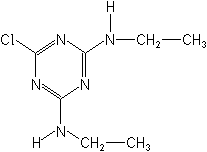Products >> Herbicides >> Simazine
Simazine
Simazine 95%TC, Simazine 50WDG
Herbicide
HRAC C1 WSSA 5; 1,3,5-triazine

NOMENCLATURE
Common name simazine (BSI, E-ISO, (f) F-ISO, ANSI, WSSA); CAT (JMAF)
IUPAC name 6-chloro-N2,N4-diethyl-1,3,5-triazine-2,4-diamine
Chemical Abstracts name 6-chloro-N,N'-diethyl-1,3,5-triazine-2,4-diamine
CAS RN [122-34-9] EEC no. 204-535-2 Development codes G 27 692 (Geigy)
Simazine APPLICATIONS
Biochemistry Photosynthetic electron transport inhibitor at the
photosystem II receptor site. Maize tolerance of triazines is attributed
to conjugation with glutathione. Mode of action Selective systemic
herbicide, absorbed principally through the roots, but also through
the foliage, with translocation acropetally in the xylem, accumulating
in the apical meristems and leaves. Uses Control of most germinating
annual grasses and broad-leaved weeds in pome fruit, stone fruit,
bush and cane fruit, citrus fruit, vines, strawberries, nuts, olives,
pineapples, field beans, french beans, peas, maize, sweet corn,
asparagus, hops, alfalfa, lupins, oilseed rape, artichokes, sugar
cane, cocoa, coffee, rubber, oil palms, tea, turf and ornamentals.
Applied at rates up to 1.5 kg/ha within the EU, and up to 2-3 kg/ha
in perennial crops in the tropics and subtropics. Phytotoxicity
Phytotoxic to a number of crops, including sugar beet, tobacco,
tomatoes, cucurbits, clover, rice, soya beans, lettuce, oats, and
many vegetables (e.g. spinach, onions, carrots, crucifers, etc.).
Formulation types GR; SC; WG; WP. Selected tradenames: 'Gesatop'
(Syngenta); 'Princep Caliber' (Syngenta); 'Princep' (USA) (Syngenta);
'Amizina' (Sipcam); 'Luserb' (Caffaro); 'Sanasim' (Sanachem); 'Simanex'
(Makhteshim-Agan); 'Simatylone LA' (Agriphar); 'Tafazine' (Rallis);
mixtures: 'Trinovin' (+ amitrole+ atrazine) (Efthymiadis)
Simazine OTHER TRADENAMES
'Azotop' (Azot); 'Mazaline' (Aventis); 'Simadex' (Aventis); 'Simatox'
(Crop Care); 'Visimaz' (Vipesco) mixtures: 'Harlequin' (+ isoproturon)
(Syngenta); 'Flandor' (+ oryzalin) (Dow AgroSciences); 'Fosmazina'
(+ glyphosate) (Probelte); 'Merit' (+ pendimethalin) (BASF); 'Sextan'
(+ isoxaben) (Dow AgroSciences); 'Simapron Doble' (+ atrazine) (Probelte);
'Simazat' (+ atrazine) (Drexel); 'Simazol Doble' (+ amitrole) (Probelte);
'Simazol' (+ amitrole) (Makhteshim-Agan); 'Terbutrex Combi' (+ terbutryn)
(Makhteshim-Agan); 'Triamex' (+ atrazine) (Aventis) Discontinued
names: 'Aquazine' * (Ciba); 'Caliber' * (USA) (Novartis); 'Primatol
S' * (Ciba); 'SimTrol' * (Griffin); 'Weedex' * (Hortichem) mixtures:
'Pramitol 5PS' * (+ prometon+ sodium chlorate+ sodium metaborate)
(Novartis); 'Etazine 3947' * (+ secbumeton) (Ciba-Geigy); 'Herbon
Blue' * (+ disul; disul-sodium) (Atlas)
Simazine ANALYSIS
Product analysis by glc with FID (CIPAC Handbook, 1980, 1A, 1343;
B. G. Tweedy & R. A. Kahrs, Anal. Methods Pestic. Plant Growth
Regul., 1979, 10, 493; AOAC Methods, 1995, 971.08). Residues determined
by glc with DMC or FPD (K. Ramsteiner et al., J. Assoc. Off. Anal.
Chem., 1974, 57, 192; B. G. Tweedy & R. A. Kahrs, loc. cit.)
or by hplc. In drinking water, by gc with FID (AOAC Methods, 1995,
991.07).
Simazine MAMMALIAN TOXICOLOGY
IARC ref. 53, 73 class 3 Oral Acute oral LD50 for rats 500-10 000,
Chinese hamsters >5000 mg/kg. Skin and eye Acute percutaneous
LD50 for rats >2000 mg/kg. Non-irritating to skin and eyes (rabbits).
Inhalation LC50 (4 h) for rats >5.5 mg/l. NOEL (2 y) for female
rats 0.5 mg/kg b.w. daily; (1 y) for female dogs 0.8 mg/kg b.w.
daily; (95 w) for mice 5.7 mg/kg b.w. daily. ADI 0.005 mg/kg b.w.
Water GV 2 mg/l (TDI 0.52 mg/kg b.w.). Toxicity class WHO (a.i.)
III (Table 5); EPA (formulation) IV EC hazard R40
ECOTOXICOLOGY
Birds Acute oral LD50 for mallard ducks >2000 mg/kg. Dietary
LC50 (8 d) for mallard ducks 10 000, Japanese quail >5000 mg/kg.
Fish LC50 (96 h) for bluegill sunfish 90, rainbow trout >100,
crucian carp >100, guppies 49 mg/l. Daphnia LC50 (48 h) >100
mg/l; (21 d) 0.29 mg/l. Algae EC50 (72 h) for Scenedesmus subspicatus
0.042 mg/l; (5 d) for Selenastrum capricornutum 0.26 mg/l. Bees
LD50 (48 h, oral and topical) >99 mg/bee. Worms LC50 (14 d) for
earthworms >1000 mg/kg.
ENVIRONMENTAL FATE
Animals In mammals, following oral administration, 65-97% is eliminated
within 24 h as the de-ethylated metabolite (Y. Deng et al., J. Agric.
Food Chem., 1990, 38, 1411). Elimination of low rates is primarily
in the urine of rats, with a shift to faecal elimination at high
doses. Excretion is rapid (c. 90% in 48 h). Degradation to desethylsimazine
and bis-desethylsimazine (diaminochlorotriazine) is the primary
metabolic pathway. Plants Readily metabolised by tolerant plants
to the herbicidally-inactive 6-hydroxy analogue and amino acid conjugates.
The hydroxysimazine is further degraded by dealkylation of the side-chains
and by hydrolysis of the resulting amino groups on the ring, with
evolution of CO2. In sensitive plants, unaltered simazine leads
to chlorosis and death. Soil/Environment Major metabolites under
all conditions are desethylsimazine and hydroxysimazine. Microbial
breakdown in soil results in degradation of simazine at very variable
rates; DT50 27-102 d (median 49 d); temperature and soil moisture
are the main factors affecting rates. Koc 103-277 (median 160);
Kd 0.37-4.66 (12 soils). Under field conditions, simazine has a
low leaching potential. Loss by direct photodecomposition is insignificant.
Indirect photodecomposition in the presence of photosensitisers
such as humic acids is, however, likely.